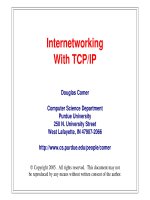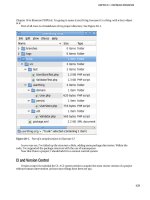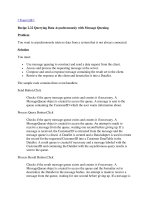Internetworking with TCP/IP- P10 docx
Bạn đang xem bản rút gọn của tài liệu. Xem và tải ngay bản đầy đủ của tài liệu tại đây (434.96 KB, 10 trang )
Internetworking Concept And Architectural
Model
Chap.
3
3.7
The User's View
Remember that TCPAP is designed to provide a universal interconnection among
computers independent of the particular networks to which they attach. Thus, we want
a user to view an internet as a single, virtual network to which all machines connect
despite their physical connections. Figure 3.3a shows how thinking of an internet in-
stead of constituent networks simplifies the details and makes it easy for the user to
conceptualize communication. In addition to routers that interconnect physical net-
works, software is needed on each computer to allow application programs to use an in-
ternet
as
if it were a single, physical network.
The advantage of providing interconnection at the network level now becomes
clear. Because application programs that communicate over the internet do not know
the details of underlying connections, they can be run without change on any computer.
Because the details of each machine's physical network connections are hidden in the
internet software, only the internet software needs to change when new physical connec-
tions are added or existing connections are removed. In fact, it is possible to optimize
the internal structure of the internet by altering physical connections while application
programs are executing.
A second advantage of having communication at the network level is more subtle:
users do not have to understand, remember, or specify how networks connect or what
traffic they carry. Application programs can be written that communicate independent
of underlying physical connectivity. In fact, network managers are free to change inte-
rior parts of the underlying internet architecture without changing application software
in most of the computers attached to the internet (of course, network software must be
reconfigured when a computer moves to a new network).
As Figure 3.3b shows, routers do not provide direct connections among all pairs of
networks. It may
be
necessary for traffic traveling from one computer to another to
pass through several routers as the traffic crosses intermediate networks. Thus, net-
works participating in an internet are analogous to highways in the
U.S.
interstate sys-
tem: each net agrees to handle transit traffic in exchange for the right to send traffic
throughout the internet. Typical users are unaffected and unaware of extra traffic on
their local network.
3.8
All Networks Are Equal
Chapter
2
reviewed examples of the network hardware used to build TCPW inter-
nets, and illustrated the great diversity of technologies. We have described an internet
as a collection of cooperative, interconnected networks. It is now important to under-
stand a fundamental concept: from the internet point of view, any communication sys-
tem capable of transferring packets counts as a single network, independent of its delay
and throughput characteristics, maximum packet size, or geographic scale. In particular,
Figure
3.3b uses the same small cloud shape to depict each physical network because
TCPIIP treats them equally despite their differences. The point is:
Sec.
3.8
All
Networks
Are
Equal
59
The
TCPLP
internet protocols treat all networks equally. A Local
Area Network like an Ethernet, a Wide Area Network used
as
a back-
bone, or
a
point-to-point link between two computers each count as
one network
Readers unaccustomed to internet architecture may find it difficult to accept such a
simplistic view of networks.
In
essence, TCPAP defines an abstraction of "network
that hides the details of physical networks; we will learn that such abstractions help
make
TCPIIP extremely powerful.
internet internet
Figure
33
(a) The user's view of a
TCPlIP
internet in which each computer
appears to attach to a single large network,
and
(b)
the structure
of physical networks and routers that provide interconnection.
3.9
The Unanswered Questions
Our sketch of internets leaves many unanswered questions. For example, you
might wonder about the exact form of internet addresses assigned to computers or how
such addresses relate to the Ethernet,
FDDI,
or
ATM
physical hardware addresses
described
in
Chapter
2.
The next three chapters confront these questions. They
describe the format of
P
addresses and illustrate how software on a computer maps
,
between internet addresses and physical addresses. You might also want to know exact-
ly what a packet looks like when it travels through an internet, or what happens when
packets arrive too fast for some computer or router to handle. Chapter
7
answers these
60
Internetworking Concept
And
Architectural
Model
Chap.
3
questions.
Finally, you might wonder how multiple application programs executing
concurrently on a single computer can send and receive packets to multiple destinations
without becoming entangled in each other's transmissions or how internet routers leam
about routes. All of these questions will be answered
as
well.
Although it may seem vague now, the direction we are following will let us leam
about both the structure and use of internet protocol software. We will examine each
part, looking at the concepts and principles as well
as
technical details. We began by
describing the physical communication layer on which an internet is built. Each of the
following chapters will explore one part of the internet software, until we understand
how all the pieces fit together.
3.10
Summary
An internet is more than a collection of networks interconnected by computers.
In-
ternetworking implies that the interconnected systems agree to conventions that allow
each computer to communicate with every other computer. In particular, an internet
will allow two computers to communicate even if the communication path between
them passes across a network to which neither connects directly. Such cooperation is
only possible when computers agree on a set of universal identifiers and a set of pro-
cedures for moving data to its final destination.
In an internet, interconnections among networks are formed by computers called
IP
routers, or
IP
gateways, that attach to two or more networks. A router forwards packets
between networks by receiving them from one network and sending them to another.
FOR FURTHER STUDY
Our
model of an internetwork comes from Cerf and Cain
[I9831
and Cerf and
Kahn
[1974],
which describe an internet
as
a set of networks interconnected by routers
and sketch an internet protocol similar to that eventually developed for the TCP/IP pro-
tocol suite.
More information on the connected Internet architecture can be found in
Postel
[1980];
Postel, Sunshine, and Chen
[1981];
and in Hinden, Haverty, and Sheltzer
[1983].
Shoch
[I9781
presents issues in internetwork naming and addressing. Boggs
et.
al.
[I9801
describes the internet developed at Xerox PARC, an alternative to the TCPlIP
internet we will examine. Cheriton
[I9831
describes internetworking
as
it relates to the
V-system.
Exercises
EXERCISES
What processors have been used
as
routers in the co~ected Internet? Does the size and
speed of early router hardware surprise you? Why?
Approximately how many networks comprise the internet at your site? Approximately how
many routers?
Consider the internal structure of the example internet shown in Figure 3.3b. Which
routers are most crucial? Why?
Changing the information in a router can be tricky because it is impossible to change all
routers simultaneously. Investigate algorithms that guarantee to either install a change on a
set of computers or install it on none.
In
an
internet, routers periodically exchange information from their routing tables, making
it possible for a new router to appear and begin routing packets. Investigate the algorithms
used to exchange routing information.
Compare the organization of a TCPlIP internet to the style of internet designed by Xerox
Corporation.
4.1
Introduction
The previous chapter defines a TCPm internet as a virtual network built by inter-
connecting physical networks with routers. This chapter discusses addressing, an essen-
tial ingredient that helps TCPm software hide physical network details and makes the
resulting internet appear to be a single, uniform entity.
4.2
Universal Identifiers
A
communication system is said to supply
universal communication service
if it al-
lows any host computer to communicate with any other host. To make our communica-
tion system universal, it needs a globally accepted method of identifying each computer
that attaches to it.
Often, host identifiers are classified as
names, addresses,
or
routes.
Shoch
[I9781
suggests that
a
name identifies
what
an object is, an address identifies
where
it is, and a
route tells
how
to get there?. Although these definitions are intuitive, they can be
misleading. Names, addresses, and routes really refer to successively lower level
representations of host identifiers. In general, people usually prefer pronounceable
names to identify machines, while software works more efficiently with compact
representations of identifiers that we think of
as
addresses. Either could have been
chosen as the TCP/IP universal host identifiers. The decision was made to standardize
on compact, binary addresses that make computations such as the selection of a route
efficient. For now, we will discuss only binary addresses, postponing until later the
questions of how to map between binary addresses and pronounceable names, and how
to use addresses for routing.
tAn
identifier that specifies where
an
object can
be
found is also called
a
locator.
64
Classful Internet Addresses Chap.
4
4.3
The
Original Classful Addressing
Scheme
Think of an internet as a large network like any other physical network. The
difference, of course, is that the internet is a virtual structure, imagined by its designers,
and implemented entirely in software. Thus, the designers are free to choose packet for-
mats and sizes, addresses, delivery techniques, and so on; nothing is dictated by
hardware. For addresses, the designers of
TCP/IP chose a scheme analogous to physical
network addressing in which each host on the internet is assigned a 32-bit integer ad-
dress called its
internet address
or
IP
address.
The clever part of internet addressing is
that the integers are carefully chosen to make routing efficient. Specifically, an IP ad-
dress encodes the identification of the network to which a host attaches as well as the
identification of a unique host on that network. We can summarize:
Each host on a
TCPLP
internet is assigned a unique 32-bit internet
address that is used in all communication with that host.
The details of IP addresses help clarify the abstract ideas. For now, we give a sim-
plified view and expand it later. In the simplest case, each host attached to an internet
is assigned a 32-bit universal identifier as its internet address.
A
prefix of an IP address
identifies a network. That is, the IP addresses in all hosts on a given network share a
common prefix.
Conceptually, each address is a pair
(netid, hostid),
where
netid
identifies
a
net-
work, and
hostid
identifies a host on that network. In practice, however, the partition
into prefix and suffix is not uniform throughout the entire internet because the designers
did not specify a single boundary. In the original addressing scheme, which is known
as
classful,
each IP address had one of the first three forms shown in Figure
4.
lt.
Class
A
101
netid hostid
I
class
B
F101
netid hostid
I
CI~SSC
[111101
netid
I
hostid
CI~SSD
111111101
multicast address
I
CIassE
F1111111
reserved for future use
Figure
4.1
The five forms of Internet
(IP)
addresses used with the original
classful addressing scheme. The three primary classes,
A,
B
and
C, can be distinguished by the first three bits.
+The fourth form, reserved for internet multicasting, will be described later; for now, we will restrict our
comments to the fonns that specify addresses of individual objects.
Sec.
4.3
The
Original Classful Addressing
Scheme
65
In the classful addressing scheme, each address is said to be
self-identifying
be-
cause the boundary between prefn and suffix can be computed from the address alone,
without reference to external information. In particular, the class of an address can
be
determined from the three high-order bits, with two bits being sufficient to distinguish
among the three primary classes. Class
A
addresses, used for the handful of networks
that have more than 216 (i.e., 65,536) hosts, devote
7
bits to netid and 24 bits to hostid.
Class
B
addresses, used for intern~ediate size networks that have between 28 (i.e., 256)
and 216 hosts, allocate 14 bits to the netid and 16 bits to the hostid. Finally, class
C
ad-
dresses, used for networks that have less than 28 hosts, allocate 21 bits to the netid and
only
8
bits to the hostid. Note that the
IP
address was originally defined in such a way
that it was possible to extract the hostid or netid portions quickly. Efficiency was espe-
cially important for routers, which use the
netid portion of an address when deciding
where to send a packet. We will return to the discussion of efficient route lookup after
examining recent changes and extensions to the addressing scheme.
4.4
Addresses Specify Network Connections
To simplify the discussion, we said that an internet address identifies a host, but
that is not strictly accurate. Consider a router that attaches to two physical networks.
How can we assign a single IP address
if
the address encodes a network identifier as
well as a host identifier?
In
fact, we cannot. When conventional computers have two
or more physical connections they are called
multi-homed hosts.
Multi-homed hosts
and routers require multiple
IP
addresses. Each address corresponds to one of the
machine's network connections. Looking at multi-homed hosts leads to the following
important idea:
Because
IP
addresses encode both a network and a host on that net-
work, they do not specify an individual computer, but a connection to
a network.
Thus, a router connecting
n
networks has
n
distinct
IP
addresses, one for each network
connection.
4.5
Network And Directed Broadcast Addresses
We have already cited the major advantage of encoding network inforn~ation in in-
ternet addresses: it makes efficient routing possible. Another advantage is that internet
addresses can refer to networks as well as hosts.
By
convention, hostid
0
is never as-
signed to an individual host. Instead, an IP address with hostid portion equal to zero is
used to refer to the network itself.
In
summary:
Classful Internet Addresses Chap.
4
Internet addresses can be used to refer to networks as well as indivi-
dual hosts.
By
convention, an address that
has
all bits of the hostid
equal to
0
is reserved to refer to the network.
Another significant advantage of the internet addressing scheme is that it includes a
directed broadcast address that refers to all hosts on the network. According to the
standard, any address with the
hostid consisting of all
Is
is reserved for directed broad-
'
cast?. When a packet is sent to such an address, a single copy of the packet is
transferred across the internet from the source. Routers along the path use the netid
portion of the address when choosing a path; they do not look at the host portion. Once
the packet reaches a router attached to the final network, that router examines the host
portion of the address to determine how to deliver the packet.
If
it finds all Is, the
router broadcasts the packet to all hosts on the network.
On many network technologies
(e.g., Ethernet), broadcasting is as efficient as uni-
cast transmission; on others, broadcasting is supported by the network software, but re-
quires substantially more delay than single transmission. Some network hardware does
not support broadcast at all. Thus, having an
IP
directed broadcast address does not
guarantee the availability or efficiency of broadcast delivery.
In
summary,
ZP addresses can be used to specify a directed broadcast in which a
packet is sent to all computers on a network; such addresses map to
hardware broadcast,
if
available.
By
convention, a directed broad-
cast address
has
a valid netid and has a hostid with all bits set to
I.
4.6
Limited Broadcast
The broadcast address we just described is known as directed because it contains
both a valid network
ID
and the broadcast hostid.
A
directed broadcast address can be
interpreted unambiguously at any point
in
an internet because it uniquely identifies the
target network in addition to specifying broadcast on that network. Directed broadcast
addresses provide a powerful (and somewhat dangerous) mechanism that allows a re-
mote system to send a single packet that will
be
broadcast on the specified network.
From an addressing point of view, the chief disadvantage of directed broadcast is
that it requires knowledge of the network address. Another form of broadcast address,
called a limited broadcast address or local network broadcast address, provides a
broadcast address for the local network independent of the assigned
IP
address. The lo-
cal broadcast address consists of thirty-two Is (hence, it is sometimes called the "all
Is" broadcast address).
A
host may use the limited broadcast address as part of a start-
up procedure before it learns its
IP
address or the IP address prefm for the local net-
work. Once the host learns the correct IP address for the local network, however, it
should use directed broadcast.
?Unfortunately,
an
early release of TCPm code that accompanied Berkeley
UNIX
incorrectly used
all
zeroes for broadcast. Because the error stilt survives, TCPm software often includes
an
option that allows a
site to use
all
zeroes for directed broadcast.
Sec.
4.6
Limited
Broadcast
67
As a general rule, TCP/IP protocols restrict broadcasting to the smallest possible
set of machines. We will see how this rule affects multiple networks
that
share ad-
dresses in the chapter on subnet addressing.
4.7
Interpreting Zero To Mean "This"
We have seen that a field consisting of 1s can
be
interpreted to mean "all," as in
"all hosts" on a network.
In
general, internet software interprets fields consisting of
0s
to mean "this." The interpretation appears throughout the literature. Thus, an
IP
ad-
dress with hostid
0
refers to "this" host, and an internet address with network
ID
0
refers to "this" network. Of course, it is only meaningful to use such an address
in
a
context where it can
be
interpreted unambiguously. For example, if a machine receives
a packet in which the netid portion of the destination address is
0
and the hostid portion
of the destination address matches its address, the receiver interprets the netid field to
mean "this" network
(i.e., the network over which the packet arrived).
Using
netid
0
is especially important in those cases where a host wants to com-
municate over a network but does not yet know the network IP address. The host uses
network
ID
0
temporarily, and other hosts on the network interpret the address as mean-
ing "this" network. In most cases, replies will have the network address fully speci-
fied, allowing the original sender to record it for future use. Chapters 9 and
23
will dis-
cuss in detail mechanisms a host can use to determine the network
ID
of the local net-
work.
4.8
Subnet And Supernet Extensions
The addressing scheme described so far requires a unique network prefix for each
physical network. Although that was, indeed, the original plan, it did not last long.
In
the 1980s as Local Area Network technologies became increasingly popular, it became
apparent that requiring
a
unique prefix for each physical network would exhaust the ad-
dress space quickly. Consequently, an addressing extension was developed to conserve
network prefixes. Known as
subnet addressing,
the scheme allows multiple physical
networks to share a prefix.
In
the 1990s, a second extension was devised that ignored the classful hierarchy
and allowed the division between prefix and suffm to occur at an arbitrary point.
Called
classless addressing
or
supernetting,
the scheme allows more complete utiliza-
tion of the address space.
Chapter 10 will consider details of the subnet and supernet addressing extensions.
For now, it is only important to know that the addressing scheme has been extended,
and that the original classful scheme described in this chapter is no longer the most
widely used.









